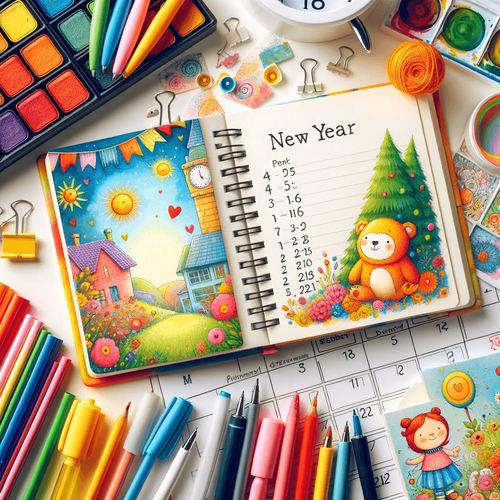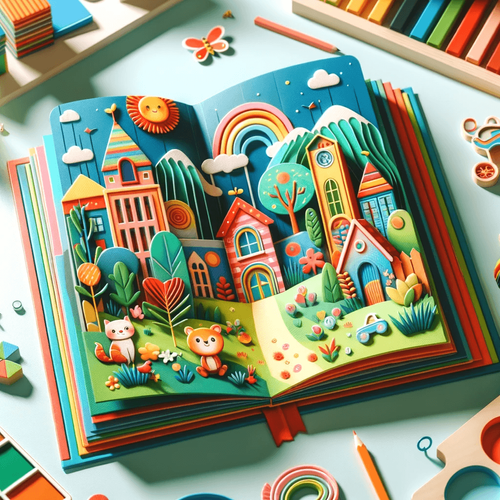Every new year brings with it a sense of new beginnings and renewed energy. For aspiring authors of children's picture books, this is the perfect time to revamp your writing routines, set ambitious goals, and commit to bringing your creative visions to life.
Let's explore how you can rejuvenate your writing process, seek inspiration from the world around you, and embrace new storytelling techniques to craft enchanting tales for young readers.
Setting and Sticking with New Writing Goals
Creating a consistent writing routine is essential for authors, but the New Year provides an opportunity to reevaluate and set new goals. Consider what you want to achieve with your writing this year. We often suggest trying to "start with the end in mind". How do you know how to get there if you haven't figured out where it is you're trying to go?
Are you wanting to complete a manuscript, refine your storytelling skills, or perhaps this is the year you want to publish? Once you've defined your main goals, break them down into actionable steps. For example:
- Daily Word Count: Set a realistic daily, weekly, or monthly word count target. Even a few hundred words a day can lead to a completed manuscript over time. Even though children's books have a lower word count than a novel, writing is like building muscle - the more you do it, the easier it is. Your writing doesn't have to be incredible every time, and not every idea will make it into a book - and that's okay!
- Regular Writing Schedule: Dedicate specific times of the day or week for writing. Consistency helps in building a habit and makes writing a natural part of your routine. I've taken to blocking time in my calendar, as I would for any other appointment, to stay accountable to myself, and setting notifications to remind me what I should be doing.
- Feedback and Revision: Plan regular sessions to review and revise your work. This means scheduling time away from working on your book. Fresh eyes can catch inconsistencies and areas for improvement.
Staying motivated can be challenging. Have you ever heard of "body doubling"? It's something that's talked about within the ADHD community, but is basically working alongside someone else who is also working to help you stay on task, especially for less-preferred or motivating tasks. Along the same lines, you might want to consider joining writing groups, participating in challenges, or finding a writing buddy. Accountability and community support are invaluable in maintaining your momentum.
Narrative Nudge: It's time to move from idea into action - write down your main authorship or publishing goals for the year. Create a note on your phone, grab a scrap piece of paper, or grab a dry erase marker (like I do all the time) and write all over your windows. Just write down your goals where you can see them.
Seeking Inspiration from the World Around You
Inspiration is everywhere, often found in the simplest moments or the most unexpected places. Here's how you can open your eyes to the world's wonders and fuel your creativity:
- Nature and Outdoors: Spend time in nature. Observe the little details, the way the light filters through leaves, the patterns on a butterfly's wings, or the stories behind a weathered building. Bonus points: leave the headphones at home and use all of your senses to take in the world.
- Children's Perspectives: If you have any kids yourself, or work with them, this one is pretty easy. If you don't, tune in to them "in the wild" any time you get a chance. Pay attention to children's conversations, their imaginative play, and their unique viewpoints. Their innocence and creativity can inspire authentic and relatable stories.
- Cultural Exploration: Dive into different cultures, traditions, and folklore. They are treasure troves of characters, settings, and plots waiting to be woven into your next story. Your local library is the perfect place to get started. I found great audiobooks and traditional tales in my Libby App (connected to my local library for free access).
- Everyday Experiences: Find magic in the mundane. A trip to the grocery store, a family gathering, or a quiet moment can spark ideas for characters or scenes. Ideas are everywhere - if you just tune in and make notes before the ideas slip away.
Narrative Nudge: Designate a place to keep notes and ideas, especially on the go. Whether it's a small notebook and pen in your bag or car, or a note on your phone, or a series of voice notes you record for yourself, get in the habit of recording ideas and inspiration as often as you can.
Embracing New Storytelling Techniques
If you've spent time reading about how to write books for children, you've likely heard the advice to read, read, read - especially books that have been published in the last 3-5 years. This is solid advice that I would echo, but there are other innovative storytelling techniques you can use to add depth and dimension to your writing. Experiment with different narrative styles, perspectives, or structures. Consider:
- Interactive Elements: Engage young readers with interactive elements like choose-your-own-adventure paths, or puzzles, hidden details in illustrations. Check out our last blog post for more ideas.
- Varied Narratives: Play with first-person, third-person, or even non-traditional points of view (POV). Each perspective offers a fresh way to tell a story. Read more about POV here.
- Rhythm and Rhyme: Common advice often says, unless you're a Julia Donaldson level rhyme-master, you should avoid it at all costs. I wouldn't go that far, because nothing makes me giddy quite like a perfectly rhymed children's book. If rhyme hits you just right, work on it! Experiment with poetic forms, rhythm, or rhyme to create memorable, read-aloud-friendly texts. Do you want more tips on reading, rhythm and rhyme from a former Speech-Language Pathologist? Let me know!
Narrative Nudge: Take a story idea and flip it on its head by brainstorming new interactive elements to include, changing the narrative point of view, or re-writing some (or all) of it using rhythm and rhyme.
Leveraging Made Live for Success
Made Live is your ally in this creative journey, offering a suite of tools and resources tailored for children's picture book authors. From initial brainstorming to the final touches before publication, Made Live supports you every step of the way. Here's how:
- Planning and Organization: Use Made Live's planning tools to outline your story, develop characters, and structure your plot.
- Editing and Illustration: Access a range of writing and editing tools to polish your manuscript and collaborate with illustrators to bring your vision to life.
- Publishing Support: When you're ready to share your story with the world, Made Live guides you through the publishing process, whether you're aiming for an eBook, print, or interactive digital format.
The New Year is a time of promise and potential. As an aspiring author of children's picture books, embrace this opportunity to revitalize your writing routine, seek new inspiration, and explore innovative storytelling techniques. With determination, creativity, and Made Live's support, you're well on your way to creating magical stories that will delight and inspire young readers for years to come. Here's to a year of fulfilled dreams and captivating tales!
If you're ready to get started, click here to start your free trial today!
Read more from our New Beginnings Series here:
Unlock Your Creativity: A New Year's Blueprint for Aspiring Children's Book Authors




